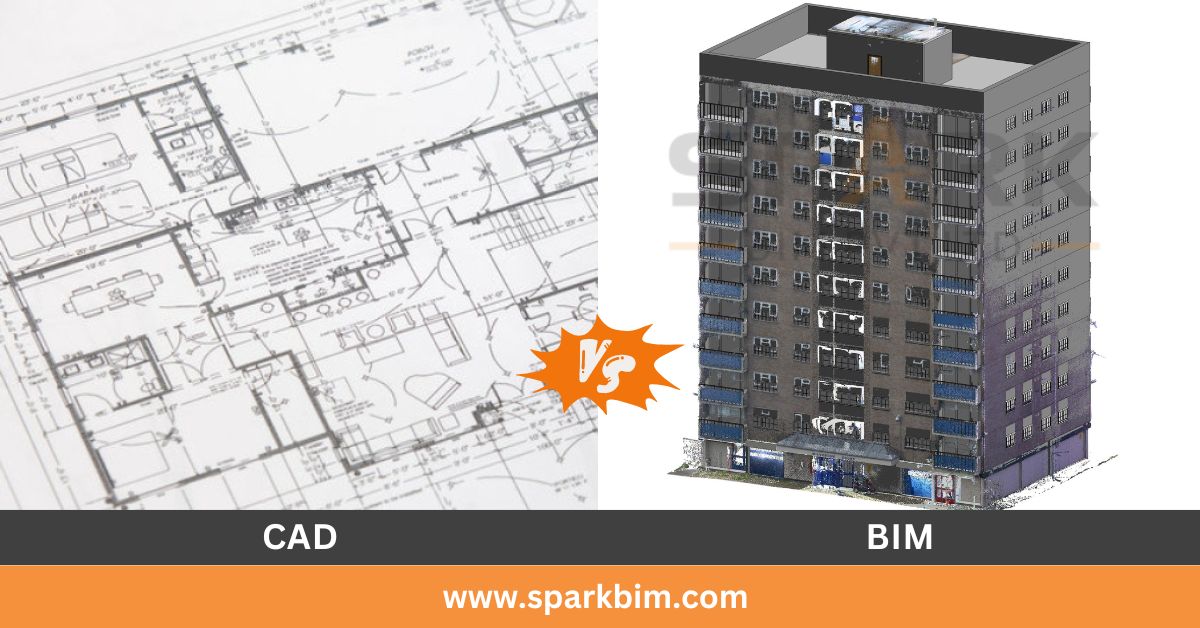Table of Contents
ToggleIn the world of architecture, engineering, and construction (AEC), CAD (Computer-Aided Design) and BIM (Building Information Modeling) are two essential technologies that have revolutionized the way buildings and infrastructure are designed, constructed, and maintained.
Both CAD and BIM have distinct features and capabilities, and understanding the differences between them is crucial for industry professionals.
In this blog post, we will dive deep into the key differences between CAD and BIM, highlighting their advantages and limitations in building design.
We will explore how each technology impacts the design process, project delivery, collaboration, and overall efficiency. So, let’s get started with a clearer understanding of both.
What is CAD
Computer-aided design (CAD) refers to the use of software to create precise drawings and models of physical objects, typically in 2D or 3D.
In the context of architecture and construction, CAD software is used by Architects, Engineers, and Designers to create blueprints, floor plans, and 3D Models of Buildings and other structures.
- 2D Drafting: Drawing floor plans, elevations, and sections.
- 3D Modeling: Creating digital representations of the building in three dimensions.
- Technical Drawings: Generating detailed technical drawings for construction purposes.
Popular CAD software includes AutoCAD, SketchUp, Revit (though Revit is more widely used for BIM), and SolidWorks.
What is BIM
Building Information Modeling (BIM) is an advanced process that integrates digital representation with data management for the entire lifecycle of a building or infrastructure project.
BIM involves creating and managing a 3D model that contains both geometric and non-geometric information, including materials, systems, cost estimations, schedules, and much more.
Unlike CAD, BIM is not just a tool for drawing but a methodology for designing and managing buildings. BIM focuses on creating a virtual model of a building that all project stakeholders, including Architects, Engineers, Contractors, and Owners, can use. BIM can be used for:
- 3D Visualization: Creating realistic models that represent the entire building design.
- Data Integration: Integrating data for materials, cost, scheduling, and building systems.
- Collaboration: Facilitating real-time collaboration and communication among team members.
Some of the most widely used BIM software include Autodesk Revit, Navisworks, ArchiCAD, and Bentley Systems.
Key Differences Between CAD and BIM
While both CAD and BIM are used in the design and construction process, their approaches, capabilities, and outcomes are fundamentally different. Let’s explore the key differences between CAD and BIM:
1. Nature of Representation
- CAD: CAD is primarily used for 2D and 3D graphical representations of a building. It focuses on creating accurate drawings, technical details, and floor plans that can be used for construction. CAD models are typically static and do not contain much data beyond geometric information.
- BIM: BIM is much more comprehensive, involving 3D models that integrate not only geometry but also non-graphic information. In addition to the building’s physical features, BIM includes data on materials, systems, quantities, costs, and performance. This makes BIM a dynamic, data-driven process that evolves throughout the lifecycle of a building.
2. Collaboration and Integration
- CAD: CAD software allows individual designers or architects to create their drawings and models, but collaboration between different project teams can be challenging. Sharing files and incorporating changes from other team members can be cumbersome and prone to errors.
- BIM: BIM is built with collaboration in mind. Multiple stakeholders—architects, engineers, contractors, and even owners—can work on a single, shared model. BIM software allows for real-time collaboration, where all parties have access to the same up-to-date information. Changes made by one team member are automatically reflected across the entire model, ensuring that everyone is working with the latest data.
3. Data and Information Management
- CAD: CAD focuses on creating precise, visually accurate representations of objects, but it does not handle or manage information beyond geometric properties. For instance, while a CAD model may accurately depict the size and shape of a door, it will not store information on the door’s material, cost, manufacturer, or installation schedule.
- BIM: BIM incorporates extensive data throughout the model, not just geometry. It includes details like material specifications, energy performance, lifecycle data, and construction schedules. This data-driven approach provides a more holistic view of the building, helping stakeholders make more informed decisions at every stage of the project.
4. Lifecycle Management
- CAD: CAD models are primarily used during the design and construction phases of a project. Once the building is constructed, CAD drawings are not typically used for ongoing maintenance or facility management.
- BIM: BIM extends beyond the design and construction phases to cover the entire lifecycle of a building, including operation and maintenance. BIM models can be used for facility management, tracking maintenance schedules, updating building systems, and even demolition when the building reaches the end of its lifecycle. This continuous use of the model makes BIM a long-term tool for managing buildings.
5. Visualization and Simulation
- CAD: While CAD allows for the creation of 3D models, the focus is primarily on technical drawing. These models are often simple visual representations without much interaction or functionality.
- BIM: BIM offers enhanced 3D visualization capabilities, including realistic renderings, simulations, and walk-throughs. These visualizations allow stakeholders to understand the building’s design and functionality better. BIM also supports advanced simulations, such as energy modeling, lighting analysis, and structural integrity assessments, which can help identify issues before construction begins.
6. Accuracy and Precision
- CAD: CAD models are precise in terms of the geometry of the building, but they can lack the level of detail and accuracy that BIM provides in terms of information management. CAD models are static and do not automatically update when changes are made elsewhere.
- BIM: BIM offers a higher level of accuracy as it integrates both geometric and non-geometric data. As a data-driven process, BIM ensures that any changes made to the model are reflected across all aspects, keeping the entire design accurate and up-to-date.
7. Cost Estimation and Scheduling
- CAD: CAD is not typically used for cost estimation or scheduling. These elements need to be handled separately, often by using other software tools that may not be fully integrated with the CAD design.
- BIM: One of the key advantages of BIM is its ability to generate detailed cost estimates and schedules directly from the model. BIM integrates cost data, material quantities, and construction timelines, helping project managers create more accurate budgets and schedules. This integration can also help identify potential cost overruns and delays early in the process.
8. Clash Detection
- CAD: In CAD, identifying clashes (when two or more elements interfere with each other) must be done manually, often through visual inspection or post-construction error detection.
- BIM: BIM software includes advanced clash detection capabilities that automatically identify conflicts between different building systems (e.g., structural, mechanical, electrical). By detecting clashes in the design phase, BIM helps avoid costly changes and delays during construction.
CAD and BIM - Which One Should You Choose
Both CAD and BIM have their place in the AEC industry, but the choice between them depends on the specific needs of the project.
For simple 2D drafting and basic 3D modeling, CAD may still be a helpful tool. However, for larger, more complex projects that require collaboration, data integration, and long-term lifecycle management, BIM is the superior choice.
When to Use CAD
- Smaller projects or those with limited complexity.
- Projects that require simple 2D drafting and basic 3D modeling.
- When the project team is small, there is a limited need for collaboration.
When to Use BIM
- Large, complex projects with multiple stakeholders.
- Projects that require real-time collaboration and data sharing.
- When a comprehensive, data-driven approach is needed for the entire lifecycle of the building.
Conclusion
CAD and BIM are two essential technologies in the construction industry, but they serve different purposes. While CAD focuses on precise geometric representation, BIM takes it a step further by integrating data, improving collaboration, and enhancing efficiency throughout the building’s lifecycle.
The choice between CAD and BIM depends on the scale, complexity, and requirements of the project. However, as the industry continues to evolve, BIM is becoming increasingly popular due to its ability to streamline the design, construction, and operation processes.
Ultimately, adopting BIM can help companies stay ahead of the curve in the rapidly advancing world of building design and construction.


